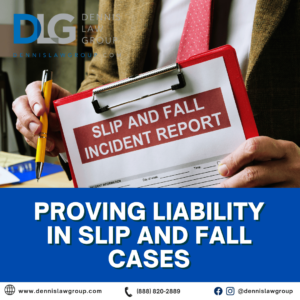Slip and fall accidents can happen anywhere and at any time, from a grocery store to a friend’s house. These accidents often result in severe injuries, leading to medical expenses, lost wages, and emotional distress. Proving liability in slip and fall cases is crucial for obtaining the compensation you deserve. In this blog post, we will delve into the intricacies of these cases, understanding negligence, gathering evidence, and seeking professional help.
Understanding Slip and Fall Cases
Before diving into the legal aspects, it is essential to comprehend slip and fall accidents. A slip and fall accident occurs when a person loses their footing due to hazardous conditions on someone else’s property. Common causes include wet floors, uneven surfaces, inadequate lighting, or obstructions in walkways. It is important to be aware of the potential dangers and injuries associated with slip and fall accidents, including broken bones, head trauma, or spinal cord injuries.
Proving Negligence
To establish liability in slip and fall cases, proving negligence is crucial. Negligence refers to the property owner’s failure to exercise reasonable care in maintaining safe premises. To successfully prove negligence, the following elements must be established:
- Duty of Care: Property owners have a legal obligation to ensure the safety of visitors on their premises. This duty includes regularly inspecting the property, promptly addressing any hazards, and adequately warning visitors of potential dangers.
- Breach of Duty: To prove negligence, it must be demonstrated that the property owner breached their duty of care. This could involve failing to fix a known hazard, ignoring maintenance issues, or neglecting to provide warnings about potential dangers.
- Causation: It must be established that the property owner’s negligence directly caused the slip and fall accident. This can be done by showing that the hazardous condition was the direct result of the property owner’s negligence and that the accident would not have occurred otherwise.
- Damages: Lastly, it is crucial to demonstrate the injuries and damages suffered as a result of the slip and fall accident. This can include medical bills, lost wages, pain and suffering, and any other expenses incurred due to the accident.
Gathering Evidence
Building a strong case to prove liability requires the collection of compelling evidence. Here are some key types of evidence that can help bolster your claim:
- Photographs: Take clear and detailed photographs of the accident scene, highlighting any dangerous conditions that contributed to your fall. Include images of wet floors, icy walkways, or any other hazards present at the time of the accident. These photographs can serve as visual evidence to support your claim.
- Witnesses: Obtain contact information from individuals who witnessed the slip and fall accident. Their testimonies can be crucial in corroborating your version of events and establishing liability. Witness statements can provide powerful support for your case, especially if they can attest to the hazardous condition or the property owner’s negligence.
- Incident Reports: Request incident reports from the property owner or manager. These reports document the details of the accident, including when and where it occurred, what caused it, and any actions taken by the property owner. Incident reports often provide an official record of the accident, strengthening your claim.
- Surveillance Footage: If the slip and fall accident occurred in a public place or a property equipped with security cameras, it is vital to secure the surveillance footage. This footage can capture the accident as it happened, providing undeniable evidence of the hazardous condition and who is at fault.
- Maintenance Records: Request maintenance records from the property owner or manager. These records can help establish a history of negligence or a lack of repairs, further supporting your claim that the property owner failed to fulfill their duty of care.
Preserving the evidence is just as important as collecting it. Ensure that your photographs are clear and captured from different angles to clearly depict the hazardous condition. Make sure to store the images in a safe place, as they may be critical during negotiations or litigation.
When gathering witness statements, it is crucial to do so as soon as possible after the incident. Memories can fade, and witnesses may become harder to locate over time. Contact the witnesses promptly and ask them to provide a detailed account of what they saw. These statements can add immense credibility to your case.
However, it’s important to note that gathering evidence and navigating slip and fall cases can be complex. This is where seeking professional help becomes crucial. To speak with an experienced slip and fall attorney, contact the Dennis Law Group today.
Free consultations are available with Our Slip & Fall Lawyers in California
If you have been involved in a slip and fall accident and are seeking to prove liability, don’t hesitate to reach out to Dennis Law Group, a team of experienced personal injury attorneys. We have a successful track record in handling slip and fall cases, and we are dedicated to fighting for your rights and securing the compensation you deserve.
Contact us today for a free consultation and let us guide you through the legal process, call (888) 820-2889 or visit https://www.dennislawgroup.com.
